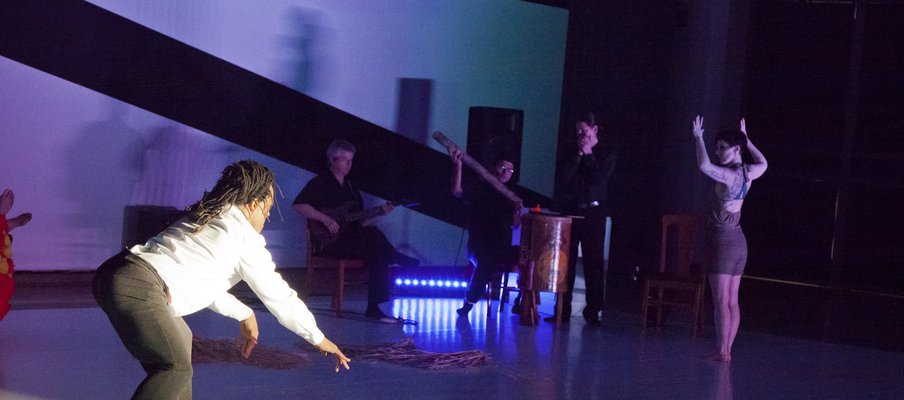
Collaboration and Cultures: Curtain Razors brings Aztec heritage to the Prairies
In this issue
 Engage - Volume 4, Issue 1, Fall 2013
Engage - Volume 4, Issue 1, Fall 2013
Related Programs
Theatre has the power to transport us to new, imaginary worlds, and recently, Regina’s
Curtain Razors brought a new world to life in their unique international performance, Codice Remix.
Codice Remix, which took over two years to create, was co-produced by Curtain Razors (an experimental theatre group) and Sâkêwêwak Artists Collective, and took place from march 14-16, 2013 at the MacKenzie Art Gallery in Regina, SK.
Working with the concept “one world in which many worlds fit”, Michele Sereda, artistic director of Curtain Razors, and Danilo Villalta, a San Salvadoran artist, partnered to create a visual enactment of the Aztec/ Maya Codice Borgia. “The Codice Borgia is a Mayan and Aztec pictorial code that documents agricultural systems,” says Sereda. “These include the making of the calendar, and ceremonial links to land based ways of being with the natural, supernatural, and living world. It’s where all of their histories come from.”
Using an interdisciplinary approach, Curtain Razors combined poetry, ceramic installation, movement, spoken word, ocarinas (clay flutes crafted by Villalta), drums, and guitar to juxtapose the Aztec legend of the Tiger of Sumpul. The performance ends with a Cree tale known as the Medawin Star Story, told by First Nations performer Erroll Kinistino. Kinistino’s storytelling was accompanied by Spanish guitarist Ramses Calderon and blues musician Billy Hughes. Dancers Meredith LaRoque and Chancz Perry were also part of the performance.
LaRoque describes her involvement, “I really loved the interconnectedness of all the [artistic] elements. It's beautiful to be in something that so many people have a hand in, however different.”
Sereda explains the unique juxtaposition of the two stories and cultures. “The Tiger of Sumpul is an oral legend that tells the story of the history of San Salvador and El Salvador. It also tells the mythic history of two [Aztec/Mayan] icons, the tiger and the deer,” she adds.
In contrast, the Star Story is about light—it talks about two Cree women looking up at the stars, the stars connect to the Aztec idea of universe and creation.
“The meshing of the stories… works well,” says Sereda. [First Nations culture] works with ideas of duality…moon and sun, light and dark, and ultimately, those ideas are happening with the Aztec culture too.”
Sereda says the collaboration between herself and Villalta, who is also an independent expert on Aztec culture, began when the two artists met at a music performance. “Michele was interested in my work with ocarinas, and then we began a series of deep communications,” Villalta explains.
Sereda says, “Sâkêwêwak Artists Collective asked me if I would be interested in creating a project with them. I told them I would be interested in doing something involving Mayan or Aztec culture…and I was interested in working with Danilo,” she says. “What fascinated me most [about Aztec culture] was the subject of agriculture and development of the calendar.”
The key word that describes Codice Remix is ‘interrelationship’. “[The performance covers] the relationship between Saskatchewan and San Salvador, [as well as] the International First Nations Corridor,” Sereda says, adding that Codice Remix also addressed relationships between intercultural activity, being together and letting people tell their stories.
Villalta feels the performance is a profound experiment. "It allowed me to expand my spirit and my mind.”
Sereda adds that “ultimately, the project was about how we learn through beauty and art to create tolerance with one another.”

